Young People and the Shaping of Public Space in Melbourne, 1870-1914 by Simon Sleight

Author:Simon Sleight [Sleight, Simon]
Language: eng
Format: epub
Tags: History, Modern, 19th Century
ISBN: 9781134789979
Google: PgKOCwAAQBAJ
Publisher: Routledge
Published: 2016-02-11T16:12:37+00:00
Chapter 4
Interstitial Acts: Urban Space and the Larrikin Repertoire
On a winterâs day in the late 1870s, Anglo-Indian writer Henry Cornish alighted from his train carriage and found himself somewhat disappointed with Melbourne. âMy ⦠convictionâ, he stated in his travelogue Under the Southern Cross, âis that Melbourne, like some of the gawky, weedy âlarrikinsâ in her streets, has grown too fast in her youth, and has thus run too much to arms and legs. Her frame-work is big enough to last her for the next fifty years. What her constitution now requires is consolidation.â1 Cornishâs neat conflation of Melbourneâs growing pains with those of its youthful inhabitants suggests a relationship between the character of city space and the attributes of city dwellers. Regarded in this light, urban form and group disposition are mutually reinforcing.
Taking Cornishâs passing observations as our cue, Melbourneâs physical structure can indeed be seen to have helped nurture the larrikins in its midst. Within the unfolding pattern of the cityâs urban frame lingered gaps, vacant land, interstitial spaces: areas soon colonized by bands of working-class youths themselves located in age somewhere in the cleft between childhood and adult maturity. This chapter revisits these metropolitan settings and contends that larrikinism, a term first popularized in Melbourne in 1870 and taken to refer to âyoung rough[s], cad[s], and general mischief maker[s]â,2 is best understood as a series of âperformancesâ in space. Reading the city as a stage, key aspects of the larrikinâs repertoire â dress, speech and public behaviour â are explored and larrikin activities related to the transitional urban locations in which they occurred. The sexualized undertones of larrikin behaviour are also examined and contextualized alongside contemporary anxieties concerning the apparent precocity of native-born youth. Assessment of the attempted literary reclamation â or perhaps rather, after Cornish, the âconsolidationâ â of the larrikin rounds out the analysis, with nationalist writers demonstrating their determination to safeguard the reputation of âYoung Australiaâ by presenting a sanitized image of larrikinism for public consumption.
Download
This site does not store any files on its server. We only index and link to content provided by other sites. Please contact the content providers to delete copyright contents if any and email us, we'll remove relevant links or contents immediately.
Cecilia; Or, Memoirs of an Heiress — Volume 1 by Fanny Burney(32384)
Cecilia; Or, Memoirs of an Heiress — Volume 3 by Fanny Burney(31758)
Cecilia; Or, Memoirs of an Heiress — Volume 2 by Fanny Burney(31725)
The Great Music City by Andrea Baker(31093)
We're Going to Need More Wine by Gabrielle Union(18911)
All the Missing Girls by Megan Miranda(15415)
Pimp by Iceberg Slim(14234)
Bombshells: Glamour Girls of a Lifetime by Sullivan Steve(13933)
Talking to Strangers by Malcolm Gladwell(13142)
Norse Mythology by Gaiman Neil(13140)
Fifty Shades Freed by E L James(13129)
For the Love of Europe by Rick Steves(12375)
Crazy Rich Asians by Kevin Kwan(9133)
Mindhunter: Inside the FBI's Elite Serial Crime Unit by John E. Douglas & Mark Olshaker(9112)
The Lost Art of Listening by Michael P. Nichols(7365)
Enlightenment Now: The Case for Reason, Science, Humanism, and Progress by Steven Pinker(7091)
The Four Agreements by Don Miguel Ruiz(6551)
Bad Blood by John Carreyrou(6483)
Weapons of Math Destruction by Cathy O'Neil(6090)
